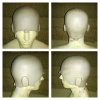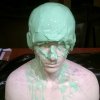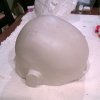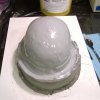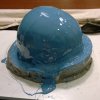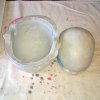Hey all, I'm continuing to work on parts for Twisty, and am prepping to make the head "scalp". I really want to do this in silicone, and punch in the hair.
The sculpture itself will be crazy simple, just ~1/4" of clay, covering the scalp area, with rugged edges. I think I'll probably do it in WED.
My concern is coming in with how best to mold the thing, so I can get good silicone pulls from it.
I don't have a bust with the head chopped in half, so the angles are going to be a little weird, since I'm essentially just making a mold of the top, and back of the head.
A few specific questions:
1. Since it's such a simple thing, I'd like to keep the mold simple as well, and avoid seams. Do you think this can be done as a 1-piece mold, or will I need 2? Kinda thinking I'll need two, but worried about a seam right across the head.
2. Would it be best to make the mold out of epoxy (e.g. EpoxAcoat)?
3. I've never cast silicone before, but it looks like Ecoflex would be a good option for this. Thoughts?
Thanks!
The sculpture itself will be crazy simple, just ~1/4" of clay, covering the scalp area, with rugged edges. I think I'll probably do it in WED.
My concern is coming in with how best to mold the thing, so I can get good silicone pulls from it.
I don't have a bust with the head chopped in half, so the angles are going to be a little weird, since I'm essentially just making a mold of the top, and back of the head.
A few specific questions:
1. Since it's such a simple thing, I'd like to keep the mold simple as well, and avoid seams. Do you think this can be done as a 1-piece mold, or will I need 2? Kinda thinking I'll need two, but worried about a seam right across the head.
2. Would it be best to make the mold out of epoxy (e.g. EpoxAcoat)?
3. I've never cast silicone before, but it looks like Ecoflex would be a good option for this. Thoughts?
Thanks!
Last edited:

